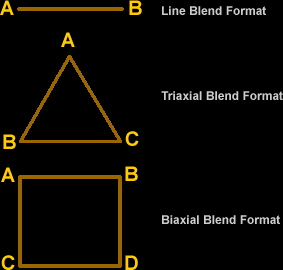|
A recipes blend
is a systematic transition from one recipe to another different
recipe. The blend consists of a series of glazes which "step"
from the original recipe to the new recipe. The blend can have any
number of "steps" or samples but Matrix has a set number
of samples in each blend it can create.
Blends are designed
to systematically explore change. You may want simply to explore
the systematic changing of a material such as clay in a recipe or
you want to see the results of changing the quantity(s) of colourant.
More complex
blends may be generated to show specific changes in parts of the
unity formula of a recipe.
In all cases
designing the blend is the essential first step. Your blend will
be all the more successful if you have a clear idea of what you
want to achieve.
Designing
the Blend Parameters - Corner Recipes
 |
Before
Matrix can generate a blend it must know what the "corner"
recipes are. e.g the "corner recipes"
- for
a line blend would be the starting point recipe (A)
and the end point recipe (B).
- for
a triaxial blend would be the recipes at the corners
of the triangle format of the blend recipe (A) recipe (B)
and recipe (C)
- for
a biaxial blend would be the recipes at the corners
of the quadrangular format of the blend recipe (A) recipe
(B), recipe (C) and recipe (D)
|
The recipes
to be placed at the corners of whatever blend you are creating must
be present on your computer as
individual recipe files.
They can be
entered in the Recipe to Formula environment or the Formula to Recipe
environment and saved in a special folder created for the blend.
There is a folder in the Matrix folder called Blends. It is good
practice to create inside the blends folder a new folder for each
blend you make. The corner recipes for each blend can be located
here where they will eventually be joined by the worksheet file
and the recipe database file which will store all of the individual
recipes in the blend.
Mixing and test
firing blends particularly of the larger biaxial is time consuming.
Take care with the design of these blends to ensure your return
for time expended is worth the commitment.
Follow
these links for more information about:
|

